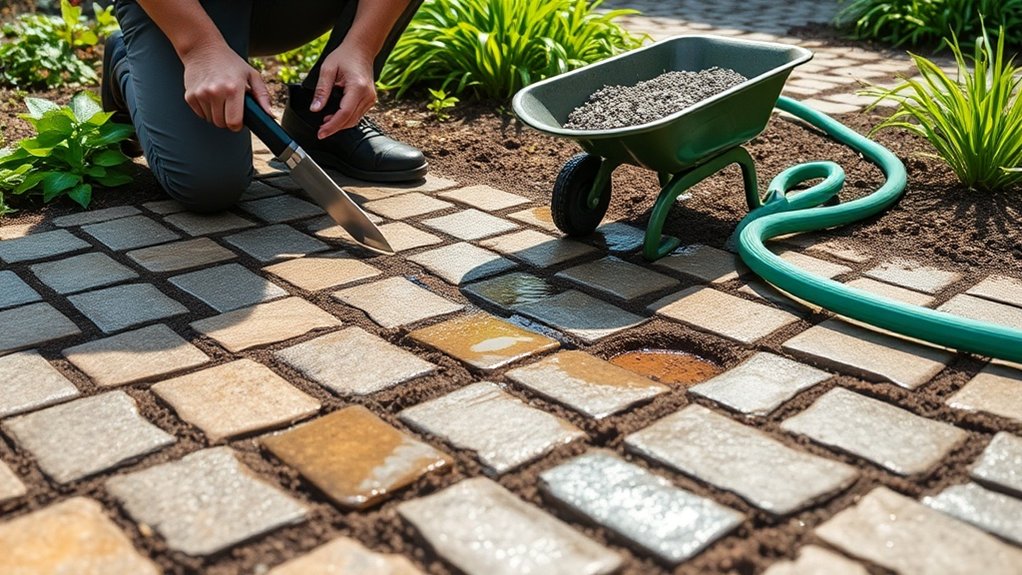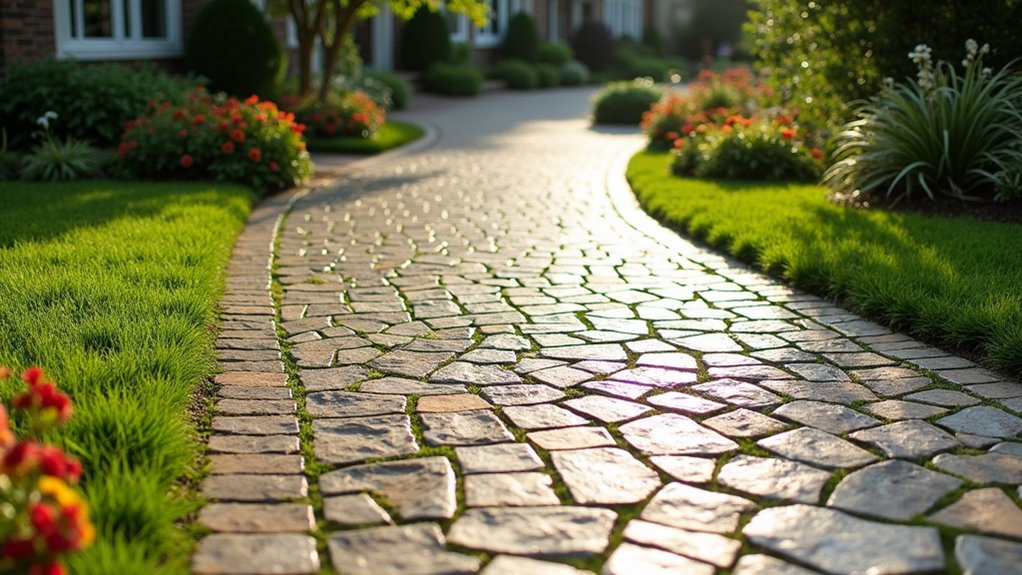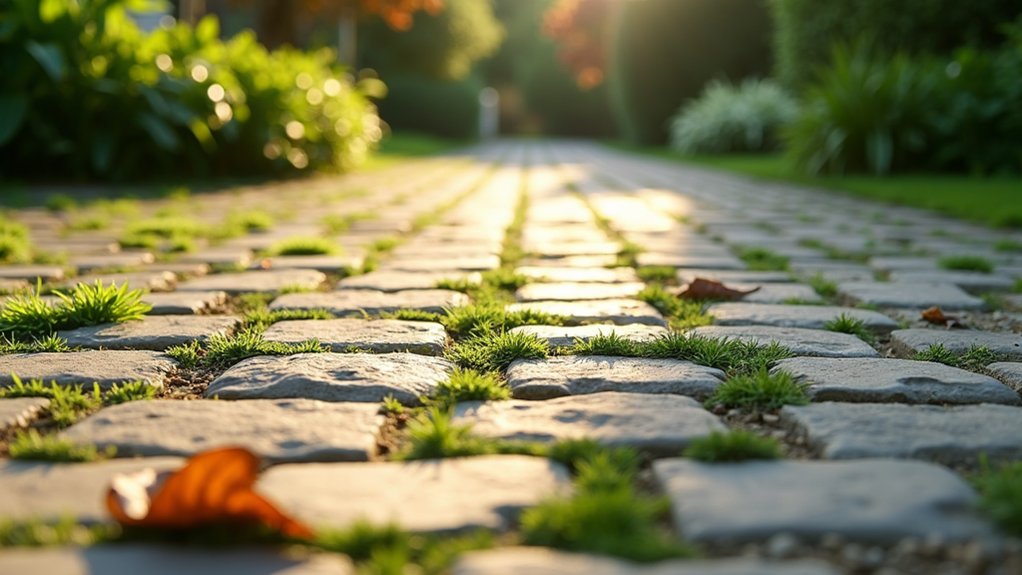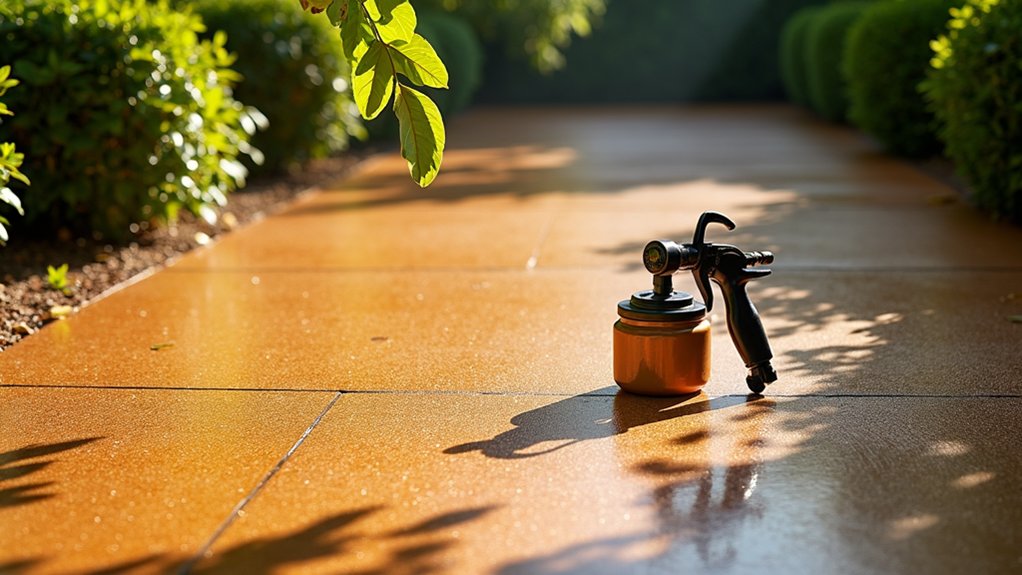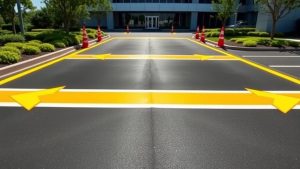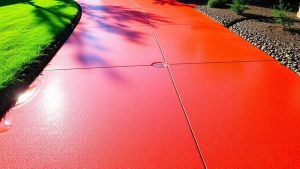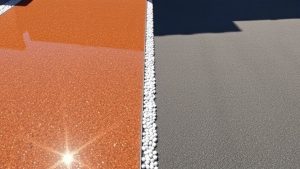To address drainage issues on your permeable driveway, begin by identifying areas where water collects and looking for any flat spots that may hold water. Check the thickness and material of your base layer to ensure it allows for stormwater drainage. Ensure proper installation with a suitable slope and well-compacted base. Consider installing drainage solutions, such as channel drains or French drains, to manage excess water. Regular maintenance is key; remember to clear debris and replenish jointing stones to keep the system effective. With these steps, you can enhance your driveway’s drainage performance.
Table of Contents
ToggleKey Takeaways
- Assess and improve the surface gradient to ensure a 1-2% slope directing water towards drainage points.
- Regularly remove debris and sediment from the driveway to prevent clogging of the pores.
- Consider installing channel drains or French drains to effectively capture and redirect surface water.
- Maintain a thick gravel sub-base beneath the surface for better water infiltration and management.
- Conduct routine inspections and maintenance every 2-3 months to quickly identify and resolve any drainage issues.
Identifying Common Drainage Problems
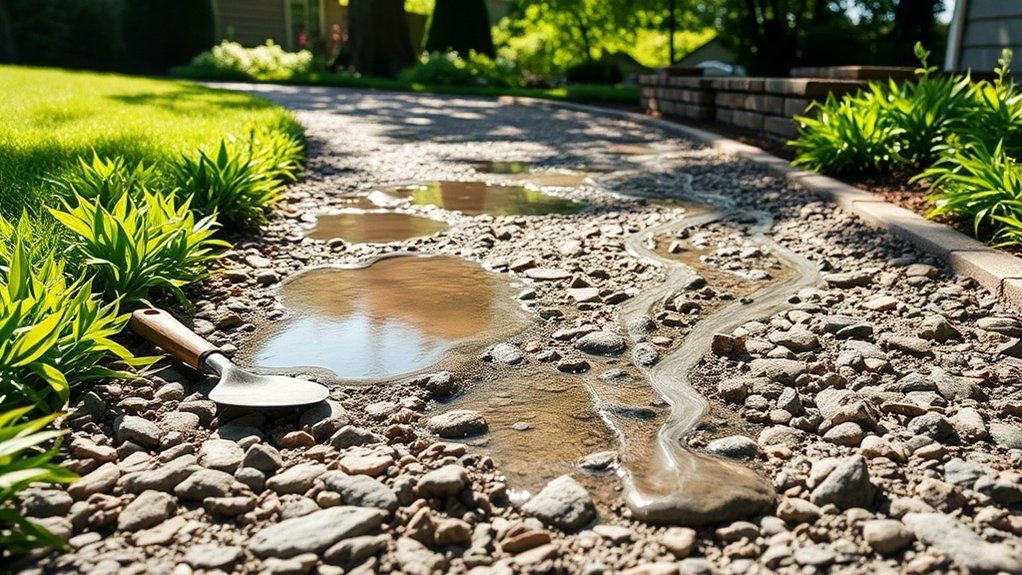
When you notice water pooling on your permeable driveway, it’s important to address the underlying drainage issues promptly. Start by identifying areas where water collects; these often indicate poor surface grading or flat spots that hinder proper runoff. Look for sources of clogging—debris, fine sediment, and oils can block pore spaces, significantly reducing infiltration capacity. Be mindful of high-traffic zones and areas with overhanging trees, as these are more susceptible to blockages. Regular maintenance, such as vacuum sweeping and pressure washing, is crucial to restore drainage efficiency and prevent further problems. Neglecting these issues can lead to surface damage and create slippery areas, as well as potential breeding grounds for mosquitoes. Implementing permeable pavers can enhance drainage capability and reduce runoff on your driveway, as they are designed to facilitate effective water drainage and support sustainable stormwater management practices.
Assessing Base Layer and Subbase Conditions
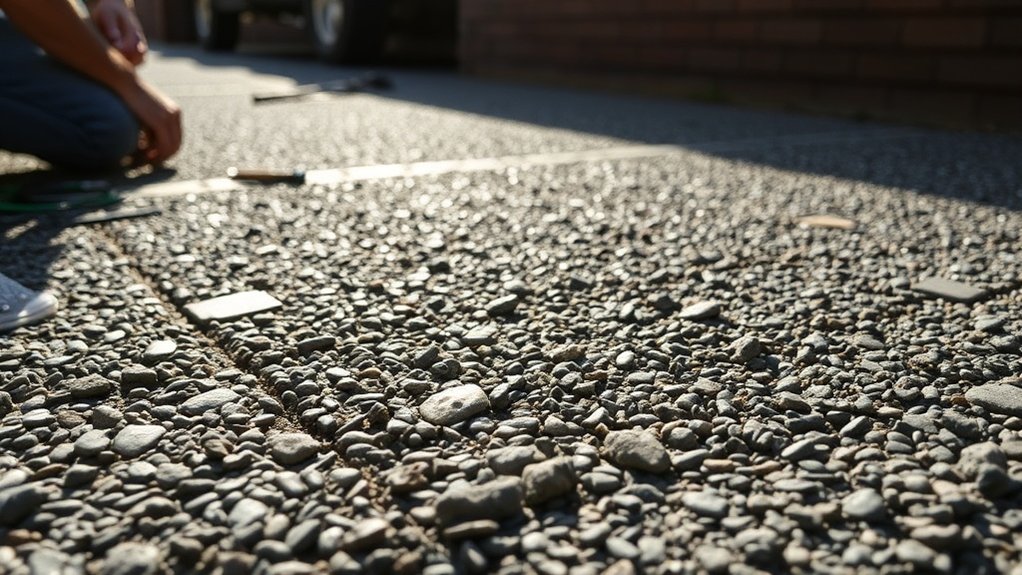
To tackle drainage issues on a permeable driveway, it’s essential to examine both the base layer and subbase conditions.
Begin by checking the thickness of the base layer, which should be between 100mm and 600mm. This layer ought to consist of uniformly sized crushed stone or gravel, ideally between 20mm and 5mm in diameter. It provides structural support and acts as a reservoir for rainwater. Additionally, ensure that the base layer allows for stormwater infiltration, as this is critical for effective drainage. The use of permeable design in the base layer enhances the driveway’s ability to handle water efficiently.
Next, look into the subbase conditions, which can vary in thickness and should include larger stone aggregates to improve water storage.
It’s also important to assess soil permeability and compaction to avoid waterlogging. The design of each layer is crucial for the overall drainage efficiency and performance of your driveway.
Enhancing Surface Installation Techniques
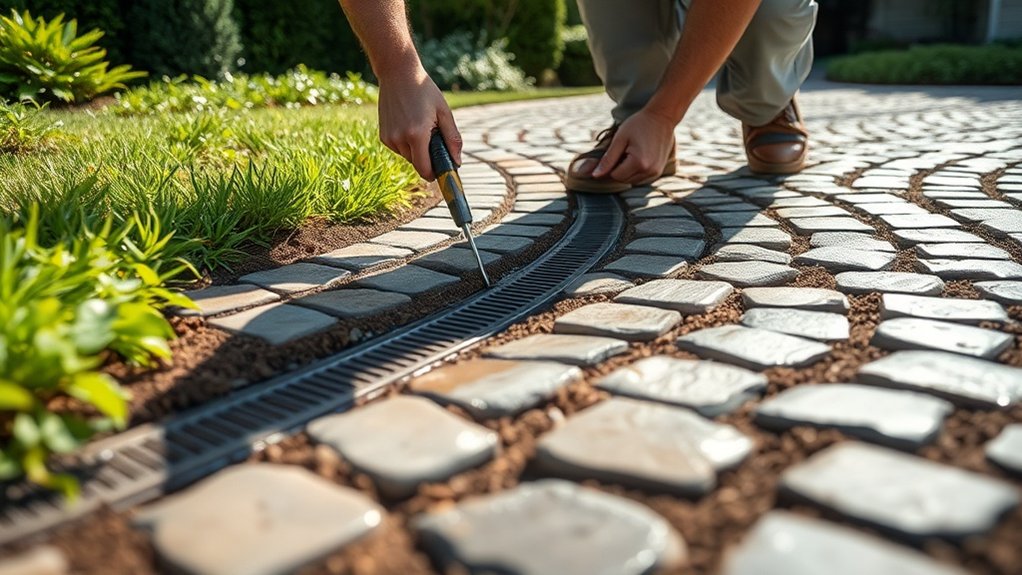
To improve the surface installation techniques of your permeable driveway, careful site preparation and layering are crucial. Follow these key steps for success:
- Establish Proper Slope: Grade the subgrade with a slight slope (1-2%) towards drainage outlets to ensure effective water flow. This slope requirement helps manage stormwater runoff efficiently.
- Achieve Paver Alignment: Start installation from a reference edge, using string lines to keep rows straight and maintain consistent spacing.
- Compact Layers: Use a plate compactor to thoroughly compact each base layer, reducing the risk of settling.
- Secure Edge Restraints: Fit sturdy edge restraints at the correct height, ensuring they align with the finished paver surface to facilitate proper drainage.
Implementing Effective Drainage Improvement Practices
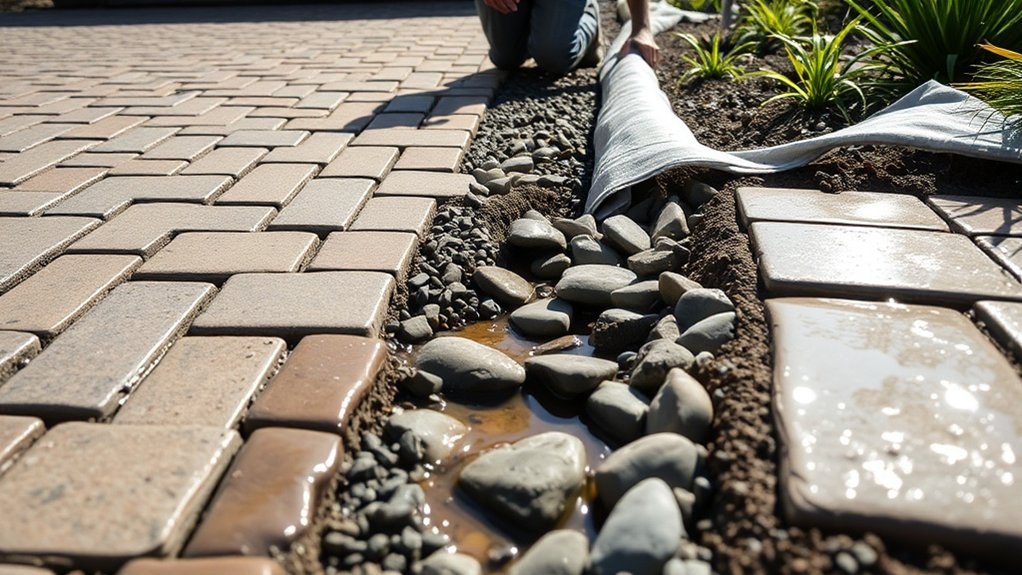
Enhancing surface installation techniques is crucial for effective drainage improvement on your permeable driveway. Start by installing channel drains to capture surface water and redirect it away from buildings.
Pair this with French drains, which use perforated pipes and gravel to filter and divert water. Catch basins are vital for collecting surface runoff at low points, helping to reduce water accumulation.
For optimal water management, combine permeable surfaces with a thick gravel sub-base and geotextile fabric to stabilise the soil. Additionally, incorporating SuDS (Sustainable Urban Drainage Systems) can enhance the overall effectiveness of your driveway’s drainage strategy.
Ensure proper grading to direct runoff towards drainage systems, maintaining a slight slope to encourage flow. By implementing these drainage solutions, you’ll manage water effectively, preventing pooling and extending the life of your driveway.
Regular Maintenance for Long-Term Performance
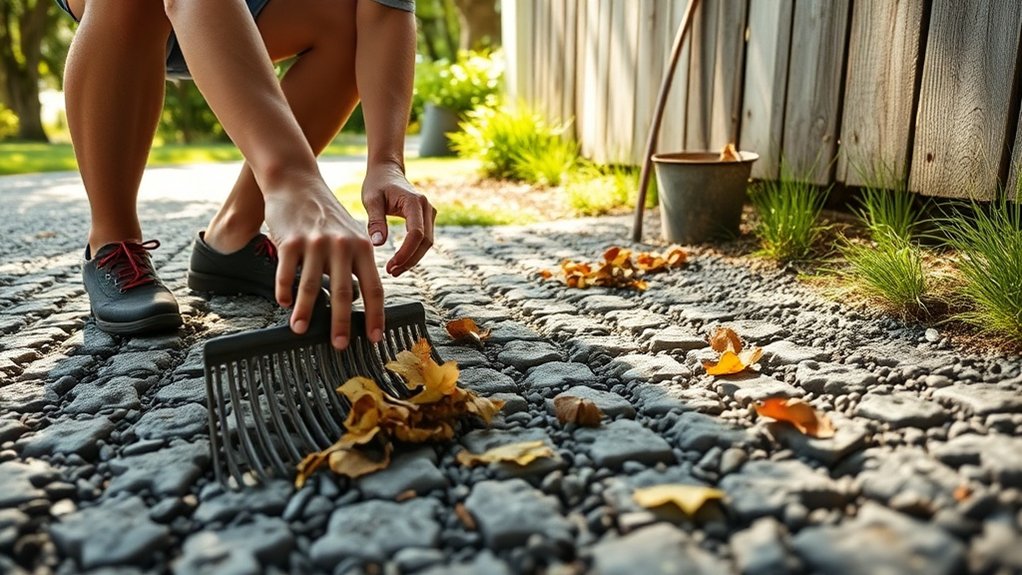
Maintaining a permeable driveway is crucial for its long-term performance. Here are some essential practices to keep it in top shape:
- Routine Inspections: Check every 2–3 months, particularly after heavy rain, to spot any drainage problems or sediment buildup.
- Surface Cleaning: Sweep weekly and vacuum when necessary to clear away debris. If stains persist, a gentle pressure wash can work wonders.
- Joint Maintenance: Replenish jointing stones every six months to ensure proper water infiltration.
- Vegetation Control: Regularly remove weeds and organic matter to prevent clogging.
Frequently Asked Questions
Can I Install a Permeable Driveway Myself?
Yes, you can install a permeable driveway yourself. Just gather the required tools and permeable materials, ensure proper site preparation, and follow the installation instructions. This will help you create a durable surface that allows for effective drainage and promotes sustainability. For example, using permeable block paving or gravel can enhance water management in your driveway.
What Materials Are Best for Permeable Driveways?
For permeable driveways, opt for gravel options like angular crushed stone for effective drainage. Consider pavers such as Eco-Optiloc or Tribeca Cobble, which offer durability and a pleasing appearance. These choices enhance water management and minimise maintenance.
How Do I Know if My Driveway Is Permeable?
To determine if your driveway is permeable, check for visible joints and a textured surface. If rainwater drains away quickly, you’re likely reaping the benefits of effective stormwater management, which helps prevent surface pooling. For example, if you notice puddles forming after heavy rain, your driveway may not be permeable.
Will Permeable Driveways Handle Heavy Rainfall?
Yes, permeable driveways can effectively manage heavy rainfall, as long as they are properly maintained. Regular cleaning and thoughtful installation of drainage solutions ensure they perform at their best, preventing water pooling and runoff during heavy downpours. For instance, ensuring that the surface is clear of debris can significantly improve drainage efficiency during a storm.
Are Permeable Driveways Suitable for All Soil Types?
Permeable driveways aren’t suitable for all soil types; around 60% of soils have poor drainage. If your soil includes clay or materials that retain water, you’ll need to incorporate specific design features to manage water effectively. For example, sandy soils typically drain well, while clay soils can cause water to pool, making permeable options less effective.
Conclusion
Addressing drainage issues on your permeable driveway is crucial for its longevity and effectiveness. Regular maintenance and proper installation are essential to ensure water flows correctly. For instance, clearing debris and checking for blockages can prevent larger problems down the line. Taking these steps now will keep your driveway in excellent condition, allowing you to enjoy a smooth surface for years to come.
Keep reading to discover how permeable driveways manage stormwater and enhance groundwater recharge while transforming your outdoor space.
Discover the secrets to the durability of permeable driveways and essential maintenance tips that could significantly extend their lifespan.
Knowing the right sealer for your resin driveway can keep it looking pristine—discover the top choices that will transform your Read more

